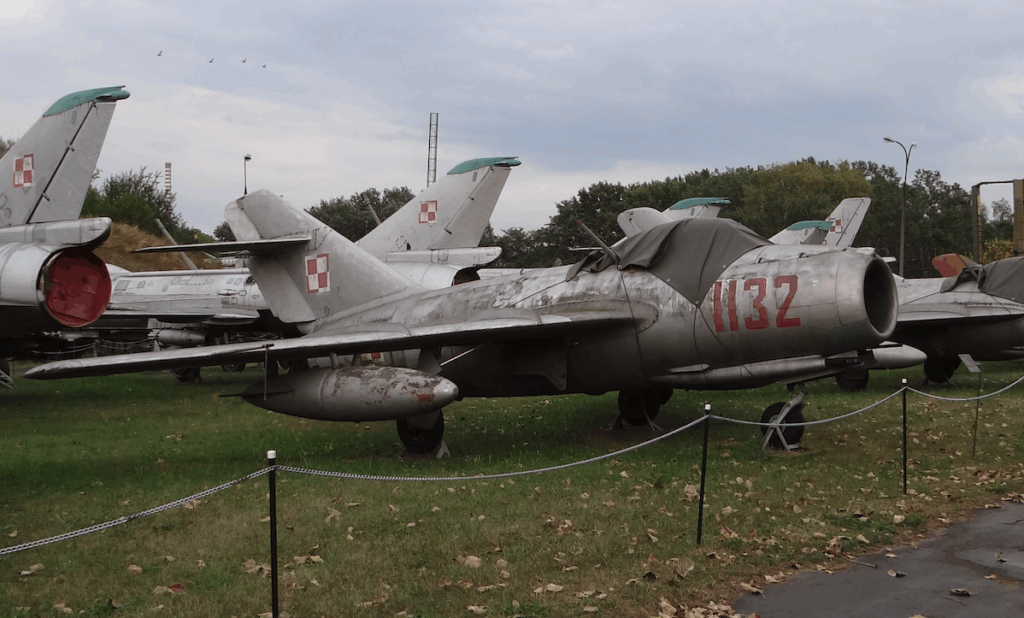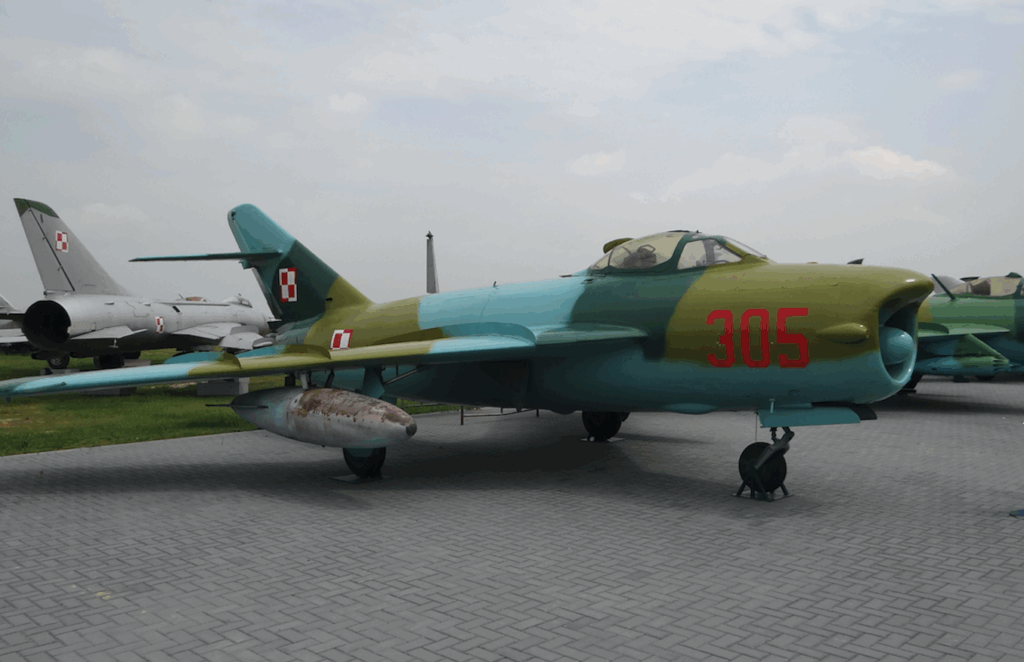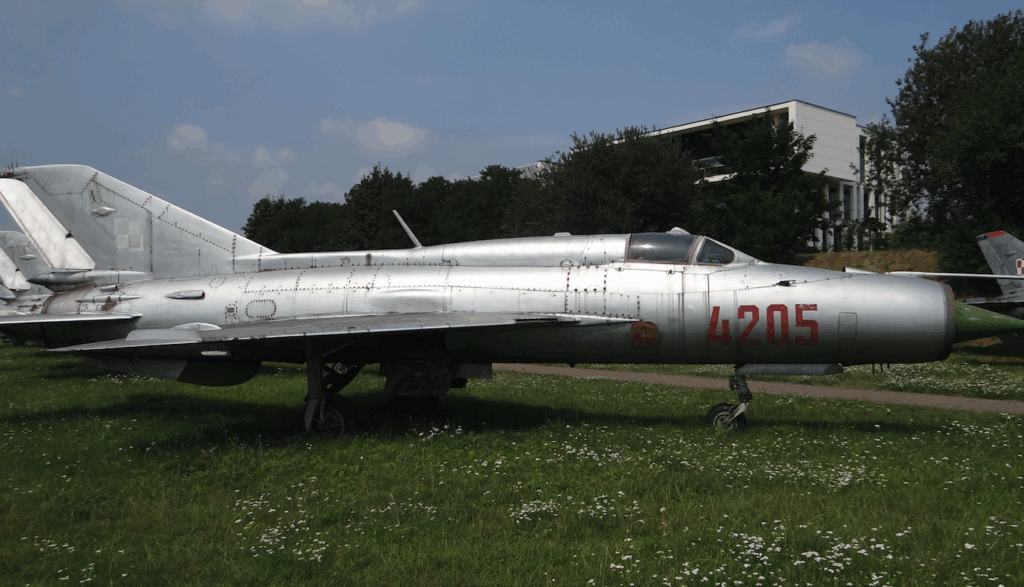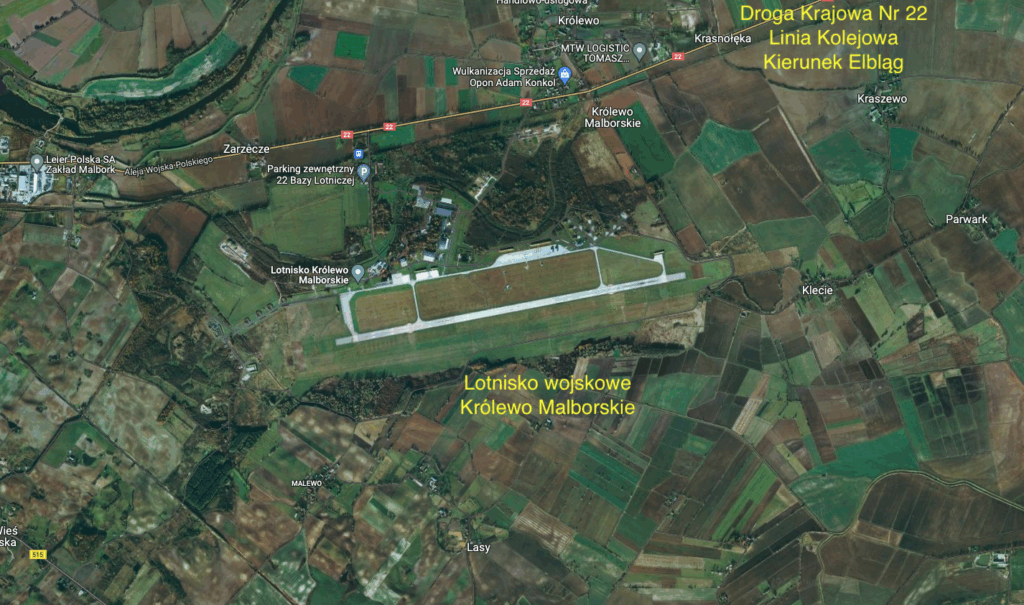Malbork 2008-01-23
41st Fighter Aviation Regiment in Malbork.
1952 – 1999
The 41st Fighter Aviation Division was established as part of the 9th Fighter Aviation Division, which later became part of the Air Force, which, during World War II, would become an offensive air force. The 9th Fighter Aviation Division was formed as the 26th Fighter Aviation Division, the 29th Fighter Aviation Division, and the 41st Fighter Aviation Division.
The Division had two primary airfields at its disposal: Malbork, where the Division headquarters was located, and Orneta. Both airfields were modernized to accommodate new turbojet fighters, as the regiments were intended to be equipped with such aircraft from the outset.
Because Poland was so devastated by World War II, it became impossible to maintain such a large number of regiments. The decision was made that each division would consist of two regiments, not three. Therefore, the newly organized 26th Airborne Regiment was transferred to the 11th Airborne Division in Świdwin and relocated to the Zegrze Pomorskie airfield. The 41st Airborne Regiment eventually settled in Malbork.
In 1952, the 41st Regiment began training in MiG-15s and UTI MiG-15 combat trainer aircraft. By early 1953, the Regiment had received its first modern MiG-15 bis fighters. This was followed by PZL Lim-2 aircraft.

Unfortunate events.
During nearly half a century of people’s democracy, from 1944 to 1989, 52 officers, 5 warrant officers, and 4 cadets from the aviation school in Dęblin defected from the Polish army to Western countries, on the verge of officer promotion. A total of 61 military personnel. This is no reason to be proud, but these are facts. I don’t want to be a judge, but a small comment cannot be avoided. Poland was enslaved by the Muscovites. Our fate was decided by the ruler in the Kremlin in Moscow, a sort of tsar of a barbaric country, supported by the local communists. In this topic, we will focus on four known escapes using MiG-15bis aircraft, accomplished by Franciszek Jarecki, Zdzisław Jaźwiński in 1953, Zygmunt Gościniak in 1956, and Bogdan Kożuchowski in 1957. Until 1953, pilot escapes in military aircraft were common, but they always ended tragically. In 1951, after a failed attempt to hijack a plane, a non-commissioned officer from the Air Force Officers’ School in Dęblin was shot. In 1952, the same happened to an instructor at the same school, Second Lieutenant Edward Pytko. While escaping by plane to West Germany, he was intercepted by Soviet pilots over East German territory, forced to land, and extradited to Polish authorities.
The first to successfully escape was Franciszek Jarecki. This happened on March 5, 1953. Less than three months later, a pilot from the 41st Air Force Regiment from Malbork, Zdzisław Jaźwiński, performed a similar feat. He also escaped in a MiG-15 bis fighter.
On May 20(25), 1953, in Malbork, the 41st Air Force Regiment scrambled at noon as part of a training exercise, as a foreign target simulated by a Soviet bomber appeared over the Baltic Sea. After the flight, Lieutenant Zdzisław Jaźwiński did not rejoin his leader, but descended, and after a 20-minute emergency flight, without landing gear, he landed on the island of Bornholm, sustaining minor damage to the aircraft. He landed on the last of his fuel, having lost significant time finding a landing site. The psychosis that gripped the leadership of the Ministry of National Defense after the hijacking of two combat jet aircraft in 1953, just two months apart (Jarecki, Jaźwiński), resulted in exceptional activity of the security authorities in the air forces.
When Zdzisław Jaźwiński defected, his regiment, the 41st Air Force Regiment in Malbork, was struck from the air force register. The regiment commander and his deputies were transferred to lower positions, and the pilots were dispersed to various so-called “forest garrisons” far from the coast. The regiment commander was sent to Warsaw to a non-flying position. Disciplinary punishments were imposed on the sweepers of the hangar where Zdzisław Jaźwiński’s plane was parked. Equipment was replaced, with the MiG-15 bis aircraft taken from Malbork.
But the most severe consequences were suffered by the commanders of three squadrons of the 41st Air Force Regiment: they were sentenced to 12 years in prison, “proving” (using methods known today) that they had helped a colleague escape and intended to hijack other aircraft. They were released in 1956, but only one was rehabilitated. Two of them, after their sentences were reduced, had their charges dismissed and were paroled. Only in 1993 was the last surviving member of the trio acquitted.
Another consequence of these two escapes, with a long-lasting impact, was the development of the secret services and the recruitment of secret agents. On June 1, 1953, the head of the Main Information Directorate, in a comprehensive order addressed to all subordinates, ordered special attention to be paid to identifying the moral and political profile of pilots with relatives in capitalist countries, compromised families, those exhibiting negative attitudes, maintaining suspicious contacts, and having uncrystallized political views. Strengthen cooperation with local public security agencies to organize agent-based and operational work in the area. Greater efforts should be devoted to comprehensive reconnaissance of officer cadets from aviation schools. This was followed by an order from the Minister of Security (No. 23 of June 2, 2013) ordering the entire public security apparatus to prioritize strengthening the protection of Polish Army units against the destructive activities of hostile forces and external elements. Provincial security authorities were also instructed to screen candidates for officer aviation schools in the same manner as candidates for employment in the Office of Security.
Both of these orders, which tightened “agent protection” over pilots and pilot candidates to the point of depravity, caused such personal tensions within the air regiments and among the cadets that—as they were causing more harm than good—they were rescinded in March 1955, essentially transforming them into another form of surveillance and oversight. The mass recruitment of pilots to prevent betrayal of the homeland—stated the head of the Main Directorate of Information in an order summarizing the results of agent activity in the air force—did not contribute to combating hostile activity; on the contrary, it created distrust, an atmosphere of suspicion, and informing among the personnel (…) and shattered the unity of the collective. The order pointed out the futility of the methods used by counterintelligence agencies among pilots (surveillance, tracking of individuals in contact with pilots, monitoring of correspondence, etc.) and concluded with the recommendation: “I hereby order (.) to intensify the work of agents in the area of detecting and preventing acts of betrayal of the Homeland, not through mass recruitment, but through the organization of deep agent work and the implementation of targeted organizational initiatives.”
Lt. Zdzisław Jaźwiński, after a rather unfortunate landing on Bornholm (unable to find an airport, he landed in a field on his last liters of fuel and crashed his plane while taxiing), after being decorated in London with the same Cross of Merit as his predecessor (Jarecki) and transported to the United States, appeared there as a “guest” of the American Air Force. Although he was not invited to the White House and did not receive a monetary award like Jarecki, he became the “attraction of the season.” He saw himself on the covers of glossy magazines, was flown around America to meetings, visited air bases, and flew military jets. He served three years in the US Air Force but refused permanent cooperation with the CIA. He worked in civilian aviation for twenty-two years (without the right to fly to Warsaw Pact countries), after which he retired.
The 41st Air Regiment (PLM) lost its importance and its combat capabilities diminished. Worse still, it was no longer a cohesive collective. The process of building a cohesive staff began anew. In the 9th Airborne Division, the 29th Air Regiment (PLM) from Orneta automatically rose to the forefront.
1958
It was not until the autumn of 1958 that the 41st Regiment regained the confidence of the Ministry of National Defence, and deliveries of new Polish-made Lim-5 aircraft began to the Regiment. The 41st PLM was the first in the Operational Aviation (WL) to receive its first five Lim-5s on 18 October 1958. The next eight aircraft landed in Malbork on 19 November 1958. The crews underwent brief training at their own airfield. The aircraft were then transferred to the 1st Squadron.

The main reason for this appreciation of the 41st Regiment was its location on the maritime border and its participation in the comprehensive air defense system by performing combat duty in the OK air defense system, even though the Regiment remained within the Operational Aviation structure.
1959
As early as June 1959, the 41st Regiment received a single MiG-17 PF from the 28th PLM OK air defense unit in Słupsk. This was the first fighter in the Regiment equipped with a radar sight.

1960.
In 1960, the first two Lim-5 Ps arrived at the 41st Regiment. These were Polish counterparts of the MiG-17 PF aircraft. The Regiment’s combat value increased, evidence of which became apparent as early as 1960. In 1960, the 2nd Central Fighter Aviation Championships of the Polish Air Force and Air Defense Command were organized. A team of nine pilots from the 41st Fighter Aviation Regiment, commanded by Captain Jerzy Zych, took first place. This was a great success for the Regiment.
In 1967, the 9th Fighter Aviation Division changed its name to the 4th Pomeranian Fighter Aviation Division.
1964.
In 1964, the first supersonic MiG-21 fighters appeared at the 41st Air Force Regiment in Malbork. They completely replaced the various versions of the Lim and MiG-17 fighters in use. MiG-21 fighters operated at Malbork for almost 40 years. These included the MiG-21 F-13, PF, PFM, R, M, MF, and bis versions, as well as the two-seater MiG-21 U and UM.
Known MiG-21s operated at Malbork:
No. Type NB / Serial No. Date Notes
1 PF 1814 / 761814 16/05/1965 From 16/05/1965 in the stock of 41st PLM in Malbork. 2 PF 1901 / 761901 10/07/1965 From 10/07/1965 in the stock of 41st PLM in Malbork. After leaving the service it went to the museum in Czyżyny ( 2002, 2007 ) 3 PF 1902 / 761902 10/07/1965 From 10/07/1965 in the stock of 41st PLM in Malbork. 4 PFM 4013 / 94 A 4013 5/08/1966 Used in 41st PLM Malbork. From 1987 in 10th PLM in Łask. 5 PFM 40.. / 94 A 40.. 5.08.1966 Used in 41st PLM Malbork. 6 PFM 40.. / 94 A 40.. 5.08.1966 Used in 41st PLM Malbork. 7 PFM 40.. / 94 A 40.. 5.08.1966 Used in 41st PLM Malbork. 8 PFM 40.. / 94 A 40.. 5.08.1966 Used in 41st PLM Malbork. 9 PFM 40.. / 94 A 40.. 5.08.1966 Used in 41st PLM Malbork. 10 PFM 40.. / 94 A 40.. 5.08.1966 Used in 41 PLM Malbork. 11 PFM 40.. / 94 A 40.. 5.08.1966 Used in 41 PLM Malbork. 12 PFM 40.. / 94 A 40.. 5.08.1966 Used in 41 PLM Malbork. 13 PFM 40.. / 94 A 40.. 5.08.1966 Used in 41 PLM Malbork. 14 PFM 4106 / 94 A 4106 5.08.1966 Used in 41 PLM Malbork. Used in 10 PLM and later 10 ELT in Łask. After leaving the service in the museum at the Poznań Citadel. 15 PFM 4107 / 94 A 4107 5/08/1966 Used in 41 PLM Malbork. 16 PFM 4108 / 94 A 4108 5/08/1966 Used in 41 PLM Malbork. 17 PFM 4109 / 94 A 4109 5/08/1966 Used in 41 PLM Malbork. 18 PFM 4110 / 94 A 4110 5/08/1966 Used in 41 PLM (4/04/1967 accident ?) 19 PFM 4111 / 94 A 4111 5/08/1966 Used in 41 PLM Malbork. (19.06.1967 accident ?)20 PFM 41.. / 94 A 41.. 5.08.1966 Used in 41 PLM Malbork. 21 PFM 41.. / 94 A 41.. 5.08.1966 Used in 41 PLM Malbork. 22 PFM 41.. / 94 A 41.. 5.08.1966 Used in 41 PLM Malbork. 23 PFM 41.. / 94 A 41.. 5.08.1966 Used in 41 PLM Malbork. 24 PFM 4204 / 94 A 4204 5.08.1966 Used in 41 PLM (23.01.1968 accident ?) 25 PFM 42.. / 94 A 42.. 5.08.1966 Used in 41 PLM Malbork. 26 PFM 42.. / 94 A 42.. 5.08.1966 Used in 41 PLM Malbork. 26 PFM 42.. / 94 A 42.. 5.08.1966 Used in 41 PLM Malbork. 27 R 1422 / 94R011422 28.09.1968 Until 1969 in 41 PLM in Malbork. Two units used for a few months in Malbork before they were sent to the 32nd Tactical Reconnaissance Aviation Regiment. 28 R 1423 / 94R011423 28/09/1968 Until 1969 in the 41st PLM in Malbork. 29 M 1815 / 961815 1970 Used in the 41st PLM Malbork. On 3/09/1970 it was damaged with only a few dozen flying hours.. It was sent to a school in Oleśnica as a teaching aid. Then around 2000 it was sold. Currently it stands in Psary and is covered with scrap purchase advertisements. ( 2007 ) 30 M 1901 / 961901 1970 Used in the 26th PLM in Zegrze Pomorskie. Since 1985 in the 10th PLM in Łask. The aircraft bears the insignia of the 1st Fighter Aviation Regiment “Warszawa” from Mińsk Mazowiecki and the 41st Fighter Aviation Regiment from Malbork. It appeared in its current location, near the shopping center at the intersection of Północna Street and national route No. 2 Warsaw – Terespol, in 2003 or 2004 (2007). 31 M 1906 / 961906 1970. Ended service with 41st Fighter Aviation Regiment Malbork. The aircraft stands in the parking lot of the Koszalin University of Technology. It was purchased to commemorate the fighter regiment (and later squadron) from Zegrze Pomorskie. Unfortunately, the monument was never built and the aircraft has been in the parking lot since then (i.e. for about two years). It has only been reassembled and refreshed. The photos show the condition of the aircraft a few days after being transported to Koszalin (2007). 32 M 2002 / 962002 1970. Used in the 41st Aircraft Regiment (31.12.1975 accident ?). 33 M 2011 / 962011 1970-1971. Used in the 41st Aircraft Regiment (20.06.1979 accident ?). 34 UM 9323 / 516999323 26.09.1980. Ended service on 19.12.2003 in the 41st ELT (former 41st Aircraft Regiment) in Malbork. The pilots were: Col. pilot Eugeniusz Garbas (commander of 22nd BLot) and Lt. Col. pilot dr Jan Rajchel (commander of 41st ELT). 35 MF 7808 / 967808 1973. Used in 41st Aircraft Regiment (31.12.1975 accident ?). 36 MF 7813 / 967813 1973. Used in 41st Aircraft Regiment (12.08.1975 accident ?). 37 MF 7905 / 967905 1973. Used in 41st Aircraft Regiment (20.09.1977 accident ?) 38 MF 9203 / 969203 1974. Used in 41 PLM (March 1984 accident?).

In 1991, the 41st Air Force Regiment had 24 MiG-21 MF aircraft and 6 MiG-21 UM aircraft.
Reformation of the 41st Air Force Regiment. December 31, 1999.
On December 31, 1999, the 41st Air Force Regiment in Malbork was reorganized into the 41st Tactical Air Squadron, which began operations on January 1, 2000.
Malbork – Airport.
The airport has geographic coordinates of 54.01 N 19.08 E and is located at an elevation of 5 m above sea level. It has a 2,500 m x 60 m runway with a concrete surface, with an orientation of 08/26.

Aircraft used by the 41st Air Force Regiment:
MiG-15, MiG-15 bis, Lim-1, Lim-2, Lim-5, MiG-17 PF, Lim-5 P, MiG-21 F-13, PF, PFM, M, MF.
Written by Karol Placha Hetman

